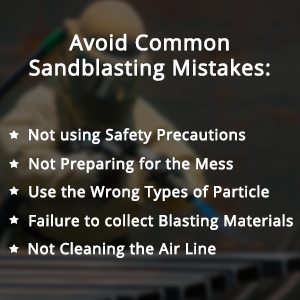Common Sandblasting Mistakes You Should Look to Avoid
When you need to clean something quickly and efficiently, sandblasting is one of the best options and Sandblaster is an incredibly powerful and useful tool. Although it is most commonly used in commercial applications, sand blasting has many applications in the home. In this cleaning method, pellets or particles are drawn from a high-speed air compressor. When these particles hit a surface, surface residues such as old paints or rust is blast away. Improper use can easily result in injury and damage property.
There are many possible errors involved in the sandblasting process. Sandblasting can be harmful and can also damage many surfaces. Here we will take a closer look at this cleaning process more closely and the most common mistakes by the owners and professionals working on residential projects.
Not using Safety Precautions
Sandblasting includes small abrasive particles that fly in the air at a very high speed. If these particles have the ability to paint off, they can significantly damage skin and other surfaces. The following safety precautions are essential for sandblasting.
Covering any exposed skin ought to be your initial concern. While a set of full body suits is not something that most homeowners have laid, they can be bought at an amazingly low cost in many paint supplies stores. These inexpensive coveralls usually consist of paper or thin fabric.

Heavy gloves are another need for the sandblast. Choose a pair that extends as far as you can from your arms. The leather is the best choice. Try to ensure that no exposed skin remains between the glove and the sleeve.
Protecting your face is also an important concern. At least glasses should be worn to protect your eyes. However, a full face mask provides even more protection. A mask with a clear shield is appropriate.
When using the Sandblasting machine, be sure to stay out of range as much as possible. Different units use different amounts of air pressure, and this affects how far the particles are flown to the user. If you rent or buy your sandblaster, be sure to ask a knowledgeable seller how far you need to stand. If you do not find anyone who knows, contact the manufacturer.
Once you have the right protection for you, be sure to keep pets and people out of the area in which you will be working. Let everyone in the home know that they will stay away until they are finished.
Not Preparing for the Mess:
Many novice sandblaster operators seriously underestimate how much mess they are going to end up making. Before you begin, make sure you are ready to clean too much dust and shed the material and that you have taken steps to prevent air pollution from spreading.
Use the Wrong Types of Particle
Using the wrong material is one of the most common sandblasting mistakes and can lead to serious damage. Cleaning a historic wall with a cut metal wire can literally destroy the surface by removing the brick itself instead of just removing the dirt. It is surprising that many particles are available for sandblasting. Although some are only available for professionals, and operators can buy a lot. These particles have different hardnesses and are suitable for different applications.
Traditional sand is the most obvious and frequent choice for sandblasting. However, do not make the mistake of using sand. Any large piece of debris in the sand, like small rocks, can cause very much damage to the surface at which you work. They are also extremely dangerous when flying at high speeds. If your home does not have sand specially designed for the use of sandblasting, look for sand intended for use in children's sandboxes. This sand is usually quite thin and free from debris.
Organic blasting materials, such as finely crust shells or baking soda, are considered some of the best options for cleaning soft surfaces such as brick work and masonry. These materials are generally the mildest available for blasting.
Failure to collect Blasting Materials
In the world of commercial sandblasting, a blasting cabinet is often used. This stand-alone unit collects the entire explosive material so it can be used frequently. This reduces waste and saves money. You can get a hint from the commercial blasting industry and collect your blasting material. A common mistake in the fight of the DIY sandblasting job is that all your abrasives literally fly away. Collecting this material and its use not only saves money but also reduces the number of times you have to carry heavy bags to your blast site.
You do not need anything as complex as a blasting cabinet to collect the most of the blasting material. A simple tarp or an old sheet on the ground will do well. Make sure you extend the sheet far enough in all directions to catch as much blasting material as possible.
Not Cleaning the Air Line
When sand blasting is used, heat and moisture may accumulate in the hose, cause to clump together of the media. Whenever you pause, make sure to rinse the air line by spraying air through the hose to clean the moisture and not moisten the media.


